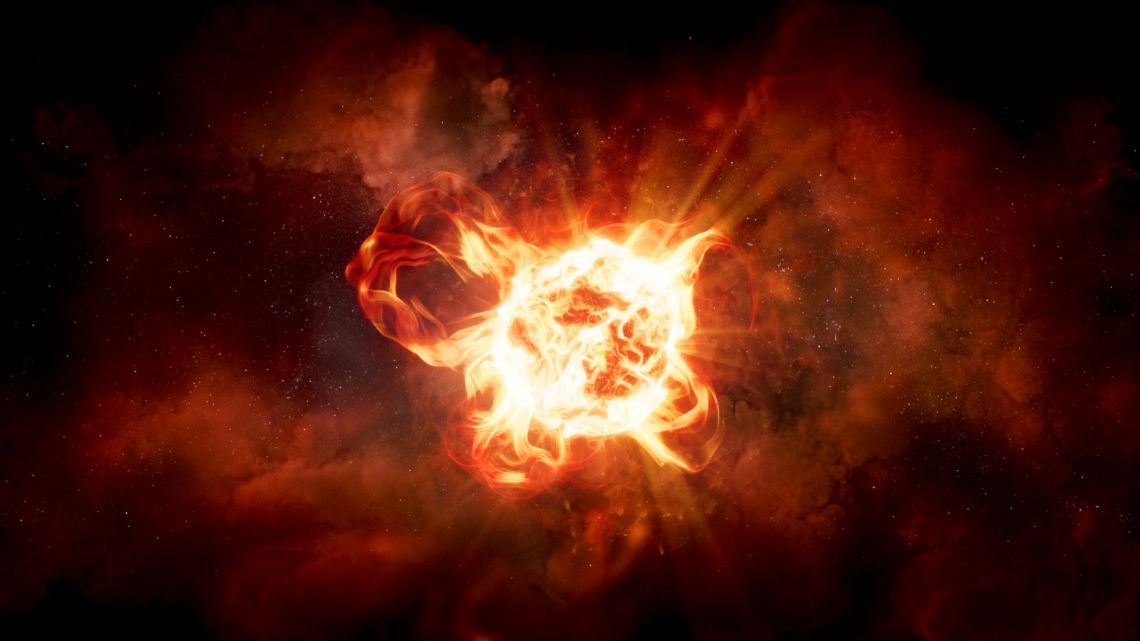
www.space.com
'Betelgeuse on steroids' sheds light on how rare massive stars die
VY Canis Majoris is dying, and astronomers are watching the red hypergiant star's final era to better understand what happens at the end of a stellar life cycle.
Science & Tech
A new map of one of the most massive stars in our galaxy is shedding light on what happens in the final stages of a giant star's death.
Astronomers created a detailed 3D map of VY Canis Majoris, a dying red hypergiant star located over 3,000 light-years from Earth. They found that the way this rare supergiant star loses mass is analogous to coronal arcs — loops of plasma that erupt from the sun — but on a scale billions of times larger.
Using the Atacama Large Millimeter/submillimeter Array (ALMA) in Chile, the team, led by University of Arizona researchers Ambesh Singh and Lucy Ziurys, traced the distributions and velocities of molecules as they swirled around VY Canis Majoris and mapped them to structures of ejected material that extend for billions of miles.
VY Canis Majoris is a pulsing variable star in the constellation Canis Major with a mass estimated to be 17 times that of the sun and a radius of 10,000 to 15,000 astronomical units (AU). (One AU is the average distance between Earth and the sun: around 93 million miles, or 150 million kilometers.)
Only a few hypergiants are known to exist in the Milky Way, including Betelgeuse and NML Cygni, and VY Canis Majoris is one of the best examples of this rare star type, according to the researchers.
"Think of it as Betelgeuse on steroids," Ziurys said in a statement. "It is much larger, much more massive and undergoes violent mass eruptions every 200 years or so."
This means that studying VY Canis Majoris offers a rare opportunity for astronomers to gain a better understanding of the processes that occur when a tremendously large star reaches the end of its life cycle. In particular, the astronomers wanted to understand the mechanisms by which this star sheds mass.
The death throes of these massive stars differ from those of lower-mass stars, such as the sun, which puff up and enter a red giant phase when they exhaust hydrogen — the fuel that powers nuclear fusion — and can no longer support themselves against gravitational collapse.
Instead, massive stars seem to experience mass loss events when they enter this stage of their existence. These events are sporadic and substantial, with the material lost forming complex, highly irregular structures composed of arcs, clumps and knots that can extend thousands of AU from the massive central star.
"We are particularly interested in what hypergiant stars do at the end of their lives," Singh said. "People used to think these massive stars simply evolve into supernova explosions, but we are no longer sure about that."
The team thinks that if these massive stars evolve into supernovas, astronomers would, theoretically, observe more of these stellar explosions. So they proposed another hypothesis.
"We now think they [hypergiant stars] might quietly collapse into black holes," Ziurys said. "But we don't know which ones end their lives like that, or why that happens and how."
Imaging VY Canis Majoris
This isn't the first time astronomers have imaged the arcs, clumps and knots that radiate from VY Canis Majoris; the Hubble Space Telescope and spectroscopy have been used to image these massive structures. With this new work, the team traced certain molecules around the hypergiant star and then mapped these findings to Hubble images of dust around the central star. This revealed hidden details of the processes involved at the end of hypergiant stars' lives, including details about how VY Canis Majoris sheds mass.
"You don't see this nice, symmetrical mass loss, but rather convection cells that blow through the star's photosphere like giant bullets and eject mass in different directions," Ziurys said. "These are analogous to the coronal arcs seen in the sun, but a billion times larger."
The team's observations of VY Canis Majoris with ALMA are still in the early stages. Yet, despite this, even this preliminary map of sulfur oxide, sulfur dioxide, silicon oxide, phosphorous oxide and sodium chloride have helped the researchers construct an image of the molecular outflow structure of the massive star. And this image is large enough to encompass all of the material ejected by the red hypergiant.
"The molecules trace the arcs in the envelope, which tells us molecules and dust are well mixed," Singh said. "The nice thing about emissions of molecules at radio wavelengths is that they provide us with velocity information, as opposed to the dust emission, which is static."
By adjusting the configuration of ALMA's 66 radio telescopes spread across Chile's Atacama Desert, the astronomers gathered details about the directions and speeds of molecules around VY Canis Majoris.
They did this on individual regions of the hypergiant and then matched the results to a timeline of mass ejection events from VY Canis Majoris . This step required major computer processing power. To get the best possible resolution, the team processed almost a terabyte of data from ALMA, with more yet to come, and detailing each molecule can take as long as two days.
"With these observations, we can now put these on maps on the sky," Ziurys said. "Until now, only small portions of this enormous structure had been studied, but you can't understand the mass loss and how these big stars die unless you look at the entire region. That's why we wanted to create a complete image."
The team's findings were presented June 13 at the meeting of the American Astronomical Society in Pasadena, California, and will be detailed in a series of upcoming papers.
























































